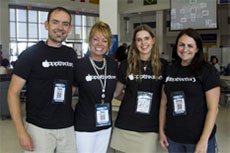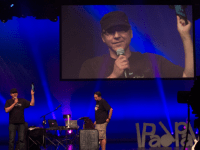It’s Time to Make Learning Fun Again, Even for Adults
Bring professional development events to life with challenges that merge collaboration, interactivity, and problem-solving in a hands-on environment for learning technology.
One of the things I’ve struggled with during my tenure in education is how professional development is done in schools, especially around integration of technology. PD is already confined to a couple of weeks in the summer, but then throw on top of that the “sit-and-get” style in which content is taught and you can see why most teachers would rather surf Pinterest than learn during these sessions. We preach how “student-centered” we want the classroom to be, yet we spend hours talking at teachers and call this “professional learning.”
While this isn’t unique to technology, I’ve found that the vast majority of technology training spends 90 percent of our time teaching us about tools, and 10 percent discussing how we could use these tools in the classroom (usually at the end of the workshop, when we are all exhausted).
The APPmazing Race
At last year’s iPadpalooza, we stumbled upon an idea that may change the way professional learning in educational technology takes place from now on. During the three-day “learning festival” (it’s not a conference), attendees were encouraged to create teams either prior to or during registration. These teams would take part in a 36-hour challenge known as the APPmazing Race (thanks to the clever Lisa Johnson for the title). The inspiration behind this concept is that learning takes place everywhere and anywhere, so why should we limit it to the individual sessions during the event? What about the time in between?

Over 40 teams took part in the inaugural race, and 18 completed all the challenges, which ranged from taking selfies with vendors to creating a digital poster of what they ate from the infamous food trailers. (Learn more about the challenges.) The race combined collaboration, interaction, problem-solving, movement, and creation all at once. There was no direct training on technology or apps. While each and every challenge required technology, it was almost invisible at the same time. The APPmazing Race was a big hit with attendees, and it got me thinking—why couldn’t we do this same thing with regular, everyday staff development?
The Interactive Learning Challenge
“Learning by doing” is not a new concept by any stretch. The famed Learning Pyramid has been around for decades. What has changed is that we all now have access to the world in our pocket. So, armed with the success of the APPmazing Race, I’ve spent the past year developing and testing a concept that I’m calling Interactive Learning Challenges (or ILCs).
At its core, an Interactive Learning Challenge starts with the concepts of collaborative problem-solving and interactive creativity, and adds an element of competition to learning. An ILC can take place over the course of several days or in one hour. It can be done with as few as a dozen people or as many as a few hundred (as was the case at iPadpalooza).
This past fall, I debuted the Interactive Learning Challenge to a group of 150 staff members at a school in San Antonio, Texas. Their superintendent had contacted me about delivering a keynote speech during their “Welcome Back” convocation. He mentioned that if I wanted, instead of the typical hour for a keynote, I could have two and a half hours to expand it into some sort of interactive workshop. This was the perfect time to try out my theory.
After setting the tone for the day, I had the entire group line up and self-identify who was the most or least tech-savvy. After that, I paired and grouped the staff to ensure that each team of four included at least one “high tech” person. The way I designed the challenges, every team member had to be participate in the creation of the final product, regardless of tech skills. Rather than confine them to the lecture hall, I placed challenges throughout the building. Completing one challenge revealed the clue to another, and so on. One staff member called it a “scavenger hunt on steroids.”
Every group completed the challenge, and after we reconvened, I asked the staff to reflect on what they had completed. Some of the takeaways were that they loved moving while they learned, and that those who had self-identified as least tech-savvy felt empowered and learned some apps they hadn’t known before. It was a huge success, and many of them send me messages even today about how engaging and interactive it was, but more importantly, about how they are trying the same thing with their kids in class.
While I don’t think this style of staff development can be applied to all topics, I’m working on making a series of “recipes” based on subject matter, group size, device availability, and time frame so that others may try this same approach to professional learning. My hope isn’t so much for Interactive Learning Challenges to revolutionize the way we do professional development around technology as much as it is to maximize the time we have for learning.
And it doesn’t hurt if the learning is also fun, right?
